Phoenicians in America: Is the Paraiba Stone of Brazil Genuine?
The main purpose of this article is not to change the mind of skeptics, rather to clarify the interpretation of the Paraiba Inscription of Brazil written in ancient old world Phoenician. Fraud or genuine, the scientific method would require at least as much for the research of such a claim. The benefits will either help clarify the extent to which ancient Phoenician was understood by 17
th Century scholars or it will help determine the greater extent of the Old World’s discovery of America.
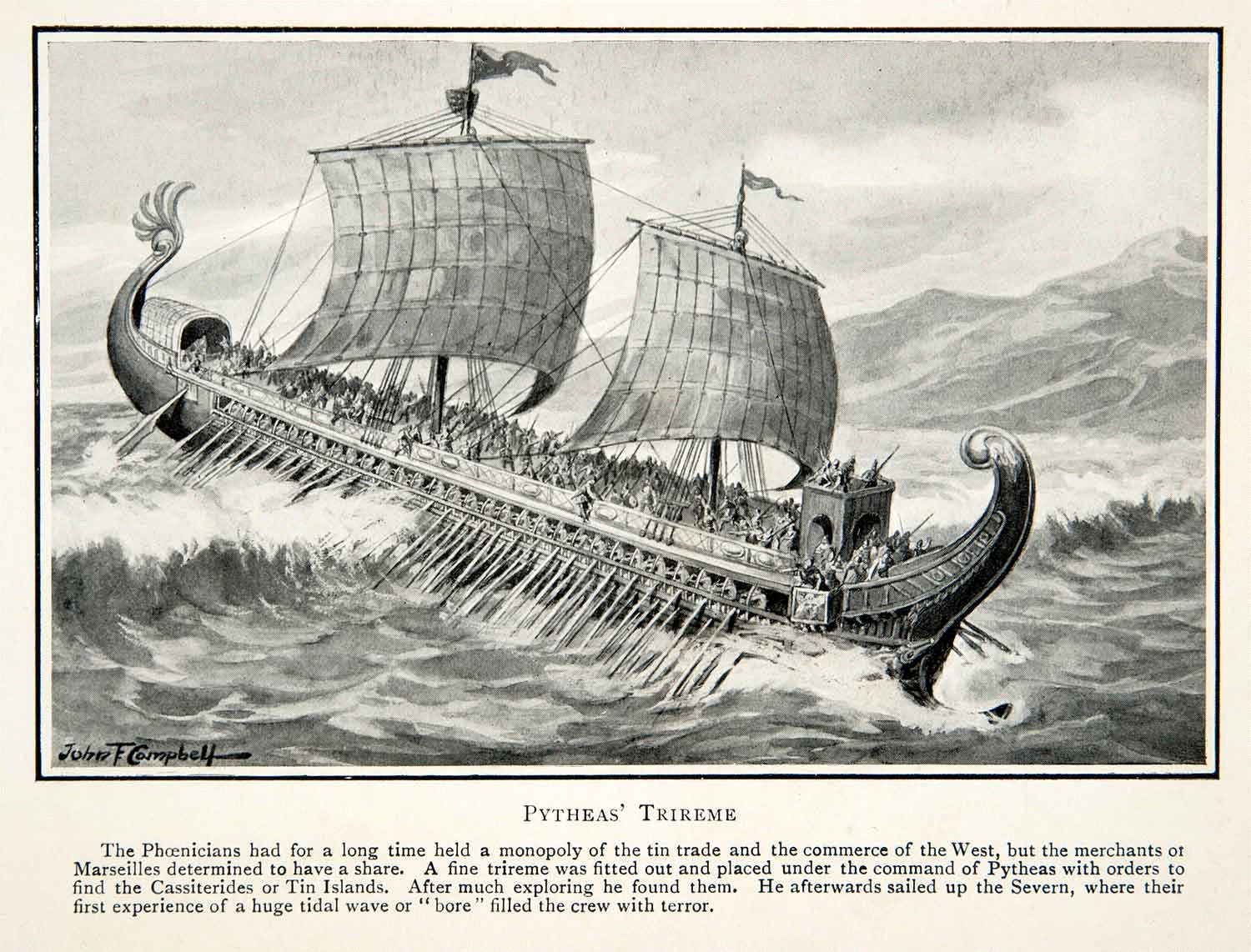
For the purposes of this study, Hebrew is to be read from right to left (in the opposite direction of English). Hebrew writing contains three letter root words (occasionally two) with affixes added to the word to expand its meaning. Most of these affixes used in this lesson are labeled in the chart below:
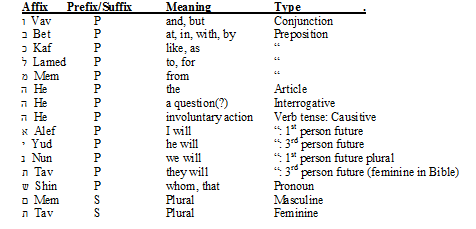
The alleged forged inscription was circulated by Ladislau de souza Mello Netto in 1872. Netto, the interim director of the Museu National in Brazil, claimed the inscription was Phoenician (an ancient Sematic language) and since it was found on a farm in Paraiba, Brazil, proved that there was an ancient American contact with the Old World. A translation was also provided in 1967 by Cyrus Herzel Gordon, expert in Semitic languages and head of the Department of Mediterranean Studies, Brandeis University, Waltham, Massachusetts. In the opinion of those who believe the inscription is a fraud, it is highly suspicious that the stone itself has never been found and that it was said to be found in four pieces much like the Moabite Stone of King Mesa found in Jordan and published in 1870. As well, Netto was described as having an interest in pre-Columbian Old-World contact with the Americas. These speculations and opinions may be useful in confirming the methods and mindset of a potential fraud, however, they do nothing to determine the value of the inscription itself. This research focuses, not on the opinions of contemporary scholars of Netto’s day, nor of their character assessment of him, but on an interpretation of the inscription itself. From this interpretation a foundation will be laid towards the purpose of the Phoenician inscription.
Consider the Brazilian Paraiba inscription found in 1872 to the Jordan Moabite Stone from 1870. The first three lines from each inscription are given below:
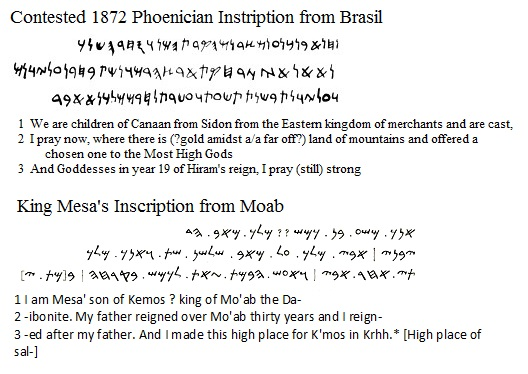
These initial three lines of 34 from the Moabite stone were chosen for their similarity with the Paraiba inscription. The remaining 31 lines relay the acts of King Mesa in victory, expansion and city building and have very few common words with the 8 lines of Phoenician words from Brazil. The critics of Netto used the Moabite stone as a precursor to a fraudulent Paraiba inscription. The reasoning that Netto would have had access to this Moabite stone research two years before coming forward with the Paraiba stone. Using an unbiased scientific method, this line of reasoning should continue to compare the two inscriptions for commonalities that would expose a work of fraud. Yet, the assumptions stop there. Taking a closer look ourselves reveals little or no commonalities that a fraud would have eagerly been ready to copy. Instead there is very little in common, especially regarding word for word matches. There is not even a sequence of even two words that match. As shown above, the most similar lines, that is, the first three lines of each inscription, have very little resemblance wording. The common elements that occur are those of writing style and etiquette. Each inscription begins with a personal introduction, which includes the year of the reign of the current king. Then they both include a sign of respect for the gods. Yet, even these aspects differ remarkably between the inscriptions. Perhaps a fraud could be sparked into writing a fake inscription after reading the newly published work on the Moabite stone, however, this line of reasoning stretches into complete conjecture and eventually a character assassination of Netto himself. Nor would a serious skeptic hold to the fact that, since both stones were reported broken in four pieces, the newer find must therefore be a fraud. An in depth study of the inscription itself is required.
To clarify the attempt of skeptics to focus on the character of the researcher, consider these lines regarding the character of Cyrus Gordan:
…but with a very fertile imagination and believes in these sensational divulgations, analyzed the apocryphal text without seeking further information about the finding…
Geraldo I. Joffily of Brasilia in the 1972 Zeitschrift der DeutschenMorgenlaendischen Gesellschaft
No doubt that further information was the unscientific character assassination of Netto, not an analysis of the scholarly decipherment of the Paraiba inscription provided by Gordan, a leading Semitic scholar, five years earlier. And who would one expect to attempt a decipherment of a Phoenician inscription found in Brazil other than someone interested in evidence of pre-Columbian transatlantic contact with America? It is clear that a skeptical scholar considering such a theory will not attempt a decipherment of an alleged Phoenician inscription from America. Maybe there is someone who enjoys knitting that we can get to decipher the stone.
Consider what was said of Netto himself from the same document:
…. He knew and possessed reasonable Hebraic knowledge on Phoenician inscriptions, not concealing his exaggerated enthusiasm about Phoenician sailing against the odds to South America and earnestly defended the existence of Atlantis….
What a nut, we should regard Netto as freakish as Plato who believed the same. More from the Zeitschrift document:
… the so-called discovery of a Phoenician inscription in Brazil would provide Ladislau Netto a rare opportunity to see his name registered by the greatest cultural centers of the world…
If it is not enough to regard Netto as the nerd of all geeks, well at least consider him too ambitious, like Julius Caesar perhaps. At some point is there any mercy for the guy? No wonder he eventually recanted his belief and said there was some anonymous fraud out there. “Et tu, Brute?” must have been his last words to the land owner of the stone who wanted nothing to do with his good name being tarnished.
Alas, is there a person willing to use the scientific method toward this reasonable inquiry: “What does the inscription itself prove if anything?”
Based on the interpretation of former scholars, a current Hebrew dictionary and a survey of the contemporary inscriptions and writing, the Phoenician Paraiba Stone inscription reads:
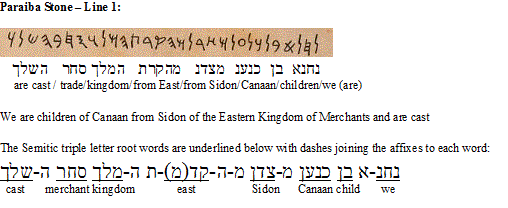
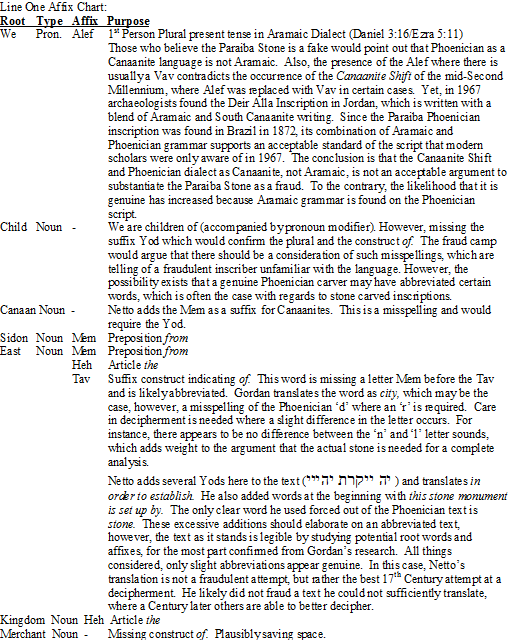

Without the complete analysis used in line one, consider the following points:
I pray, is used three times in the text. Perhaps these are the efforts of a truly lost Phoenician somewhat vigilant in prayer due to his circumstances. It is not clear why a fraud would write,
I pray, so often without making his attempt sound,
I pray, a little excessive. The word for
beside could easily be translated as ‘gold’ with a slight misspelling. Why would Netto not twist his imagination to use this word so much associated with King Hiram and the ships of Solomon’s Temple unless the work was actually not an attempt at fraud, but of strict honesty.
Gordan’s interpretation reads:
and offered a young man to the gods. This research toned down the wording to
a choice gift. It is likely that Gordan is correct, revealing something of the beliefs of these ancient castaways, while also considering their desperate circumstances.

It is true that many of the facts associated with the Biblical Hebrew text regarding the building of Solomon’s Temple with the help of King Hiram’s trading vessels. A fraudulent person might attempt to underscore this event from the Hebrew Bible. However, Biblical events are confirmed often enough in archeological finds of the Middle-East, without the necessitating fraudulent claims. More study is needed regarding new discoveries in the use of Phoenician scripts as they relate to this text, before such fraudulent explanations can be assumed.

A consideration of the trading items given by the Phoenicians related to what they exchange with inhabitants of the African coast would assist the research in understanding the advantage of merchants from Sidon embarking from the Red Sea around Africa to the Mediterranean instead of the other way around. The advantage for Sidon, is that the ships arrive at the city itself with foreign goods which are more valuable to the region than those goods they carried over land from Sidon to Ezion-geber. Their caravans would be much safer with local inexpensive items.

The three-lettered Hebrew word for separated is modified by two prefixes: the Vav representing
and; and the Nun, which somehow modifies the verb
to separate. Following the sentence structure, the affix
Nun appears to contract the words
we were separated uniting the beginning of the line to the end while eliminating the necessity of three more letters to carve. Gordan appeared aware of this abbreviation in his decipherment where Netto fell short. It appears Gordan is more skilled at translating a genuine artifact.

A similar abbreviation is used as in the above line with this lines phrase
we have come. Again, Gordan picks up on the abbreviation, while Netto misses the
Nun-we-have affix. Netto appears to know half of the roots and affixes, while Gordan picks up on most of them. For instance, Gordan translates
no longer with our companions including every two letter word in the sequence; Netto translates
carried far away from their companions which appears to be adding misused educated guesswork from earlier in the text to fill in the words he is having trouble deciphering.
Another interesting find only in Aramaic contexts is the use of the letter Samekh
?, in the word
ten where the Hebrew uses only the letter Sin,
?. This is the second indication of a clearly
Aramaic-only word on this inscription, a language confirmed to be blended into the Phoenician text of Deir Alla in the Jordan. If Netto was copying from what limited Semetic resources he had, he more than likely would have used the word for ten written in the Hebrew Bible which contains the Sin, not the Samekh. Moreover, he would not have likely even known of the Aramaic use of the Samekh in place of the Sin, much less that the Phoenicians preferred the Aramaic. Therefore, this word ‘ten’ stands out as a flag word for a genuine Phoenician inscription made by a merchant influenced by Aramaic traveling Jews.

The interpretation used in this article differs in line seven and eight from Gordan’s decipherment more than any other lines. It is suggested here that a further study of the vow or pledge used in the Hebrew Bible’s II Chronicles 6:22, may help clarify the understanding of the
making of the
pledge interpreted above. The sentence is difficult to translate. It involves understanding the abbreviation of
I make from the Alef and Shin in line 7, as it relates to the word for pledge at the beginning of line 8. In two cases above, the inscriber used this surrounding of the sentence with the main idea of the phrase in a Verb, Subject, Object phrase order often used in classical Semitic. Following the reasoning of Netto as a fraud, using his translation telling of a very limited understanding of early Semitic writing, it is unlikely that he would pick up on this style of language and use it consistently throughout a fraudulent text to make his work appear more genuine. All things considered it is more likely to be a genuine inscription written by a person who speaks the language together with these minute specifics of the dialect.

Perhaps no words can be added to such a phrase….
The Complete Paraiba Stone Translation:
The words of a stranded Phoenician in South America in the 6
th Century b.c.e.:
We are children of Canaan from Sidon of the Eastern Kingdom of Merchants and are cast, I pray, here beside a central land of mountains (with this) offered choice gift to the Most High Gods and Goddesses in year 19 of King Hiram, I pray (still) strong, from the valley of Ezion-geber of the Red Sea. Thereby (we) journeyed with 10 ships and we were at sea together assuredly two years around the land of Ham. We were separated by the hand of Baal and no longer remained among our companions, I pray, we have come here, 12 men and 3 women at this new land. Devoted, I make, even whom men of wealth bow the knee, a pledge to the Most High Gods and Goddesses (with) sure hope.
Former translations:
The underlined words correspond with the common elements between former translations and the one presented in this article.
Netto’s translation (50+% accurate) from 1872 reads:
This stone monument has been cut
by Canaanites of Sidon who, in order to establish
trading stations in distant
lands, mountainous and arid, under the protection
of the gods and goddesses, set out on a voyage
in the 19th year of the reign of Hiram our powerful king. They departed
from Ashongaber in the Red Sea, after having embarked colonists
in 10 ships; and became separated from the flagship, and carried far away from their
companions. 10
men and 3 women arrived here on this unknown coast.
Of whom I, the unhappy Metu-Astarte, servant of the powerful goddess Astarte, have taken possession. May
the gods and goddesses come to my aid.
Gordan’s translation (90+% accurate) from 1976 reads:
We are Sidonian Canaanites from the city
of the Merchantile King. We were cast up on this distant shore,
a land of mountains. We sacrificed a youth to the celestial gods and goddesses in the 19th year of our mighty King Hiram and embarked
from Ezion-geber into the Red Sea. We voyaged with 10 ships and were at sea together for 2 years around Africa (Ham). Then we were separated by the hand of Baal and were no longer with our companions. So we have come here, 12 men and 3 women, into New Shore, Am I, the Admiral, a man who would flee? Nay! May
the celestial gods and goddesses favor us well.
Conclusion:
It makes sense that the ships of Hiram would have Phoenicians who were aware of the Aramaic dialect, since Hiram worked with Solomon in gathering resources from abroad to make his temple in Jerusalem. There are at least two striking instances where Aramaic linguistic habits are used in this Paraiba inscription. A 17
th Century fraud would very likely not have been aware that Phoenician, a non-Aramaic Semitic language would borrow from the Aramaic. It was only in the late 19
th Century that such an inscription was found for comparison and confirmation, that being the Deir Alla from Jordan. As well, the inscriber speaks of his status as high enough for men of wealth to bow before him in his devoted pledge to the Most High Gods and Goddesses. His confession sounds prideful, but a similar confession by the Roman Centurion before Jesus of Nazareth was regarded favorably by Jesus. Acknowledgement of status, therefore, was a sign of humility not pride in this culture. In essence, he is saying, “I’m devotedly pleading to heaven, I whom rich men bow the knee, bend my own knee and pledge to the Gods and Goddesses in full trust.” It is not the sort of prayer you would expect a 17
th Century forger to come up with, especially when such embellishments were frowned upon by contemporaries of Netto. Instead, Netto, who did not forge the script, wrote his educated guess about the prayer as: “
Of whom I, the unhappy Metu-Astarte, servant of the powerful goddess Astarte, have taken possession. May
the gods and goddesses come to my aid.” Most of these words he has to accept as misspelled or force into the text. He is not forging what he does not understand. Instead he believes the work is genuine, but has only partial linguistic understanding of the text. What he does not understand he fills in with educated guesses and his own cultures assumptions. In 1872, Netto, together with the contemporaries who assisted him, do manage to decipher 50% of the inscription. In 1967, Gordan is far more successful with over 90% understanding of the Phoenician inscription of the Paraiba Stone. This is what you would expect from an actual genuine archaeological find. We build upon the shoulders of former scholars in our understanding of genuine texts. Those early critiques that declared this inscription a fraud appeared more interested in defaming the character of Netto than actually testing the script word for word, letter for letter. What was linguistically possible in the 17
th Century could not have fraudulently produced such a refined Phoenician inscription, much less interpret it. The scholastic atmosphere Netto had to face was cluttered with the eras’ socio-political bias, which essentially would not give a second glance to claims outside of the norm.
In reality, there were sailors before Columbus, we know of those from among the Vikings, of India and China, but now also, from the Middle East, who travelled the globe in search of new lands and found them in the Americas.
References:
http://patagoniamonsters.blogspot.ca/2011/03/phoenician-inscriptions-from-paraiba.html
http://www.livius.org/de-dh/deir_alla/deir_alla_inscr.html
http://www.badarchaeology.com/?page_id=421#comments
http://en.wikipedia.org/wiki/Deir_Alla_Inscription
http://en.wikipedia.org/wiki/Hebrew_grammar
http://www.flavinscorner.com/fe2.htm
http://en.wikipedia.org/wiki/Mesha_Stele
http://www.gentlewisdom.org/qaya/academic/hebrew/Phoenician.html
https://en.wikipedia.org/wiki/Shin_(letter)
https://www.boloji.com/member-files/mt3so9pf/pic%2016.jpg
http://nephicode.blogspot.ca/2012_03_01_archive.html
Hebrew-English Holy Scriptures. England: Clays Ltd, St Ives plc, 2002.
The Englishman’s Hebrew and Chaldee Concordance of the Old Testament. Grand Rapids, Michigan: Zondervan Publishing House, 1970.



















